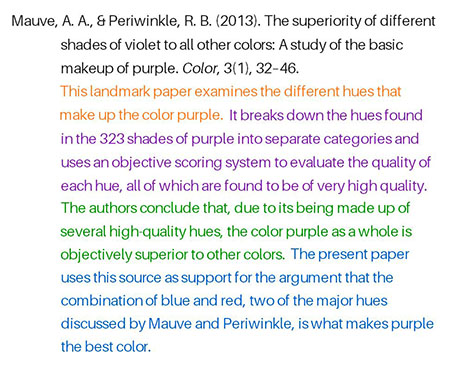Writing your first research paper can be a challenge. Learning how to find and use sources, and then cite them properly, is an endeavor that many new students find overwhelming. Some professors like to add to this stress even more by requiring not just a research paper but an accompanying annotated bibliography. Since most students have never encountered the term annotated bibliography before entering post-secondary education, this added requirement tends to leave students everywhere scratching their heads and wondering why they ever thought pursuing a degree was a good idea.
If you're just starting to acquire research skills, you probably don't even know how to create a bibliography, let alone how to write an annotated bibliography. What the heck is an annotated bibliography, anyway, and why is your professor so intent upon your learning to create one? Haven't you acquired enough skills writing the darn paper? What does this teacher want from you? Where does it end?
The madness! The audacity of this professor! It's enough to make you want to give up.
Do not despair, dear student. For, like many things in the academic world, the term annotated bibliography is much less complicated than it sounds. Here, we present to you a simple guide on how to write an annotated bibliography. We've even included a short rationale to explain your professor's reason for making you undertake this pesky extra task in the first place.
What is an annotation?
An annotation is essentially a short summary of a source's content and argument, as well as an explanation of how that source fits the argument you are making in your paper. Annotations are typically written directly after the reference list entry for a source, and they usually should not exceed 150 words. Short and concise is the goal. Be sure to check your professor's guidelines, as he or she may have different expectations for length.
Annotations should not be confused with abstracts. Although both are short summaries of particular works, an abstract accompanies an article in a journal, providing a brief description of the article's contents. An annotation further provides an evaluation of the book, article, or resource in question.
When should I write my annotations?
The basic sequence for creating an annotated bibliography should go like this:
- Decide on your thesis.
- Find sources to support your thesis, altering your thesis if necessary.
- Keep track of those sources, including what information you are taking from them, so that you can cite them properly within your paper.
- Write your paper, citations included.
- Using the information you collected during the research process, create a bibliography with annotated entries.
So, you basically want to gather the information required to write each annotation as you are writing your actual paper. You have to keep track of what you are taking from each source anyway, so this really isn't extra work. The tricky part of how to write an annotated bibliography isn't collecting the proper information—rather, it is stating that information as concisely as possible.
Breaking it down: The anatomy of an annotation
Now that you (hopefully) get the idea, here's an example of an annotated reference. This example has been taken from a paper that argued that purple is the best color because it is a combination of blue and red. Keep in mind that the example citation is written according to APA style; the formatting, particularly of the citation, is differs among the style guides, but the basic information contained in the annotation generally remains the same.
In the following example, the orange text states what the paper is about, the purple explains what makes it a credible source, the green outlines the findings of the paper, and the blue describes how the argument in the paper applies to the author's own paper.
Why do you have to learn how to write an annotated bibliography, anyway?
If you've been working on the same paper for ages, the last thing you want to do is spend more time on that paper. It may seem as if your professor is simply trying to irritate you, but rest assured, there is a reason your instructor wants you to know how to write an annotated bibliography.
The reason is that creating a list that shows exactly how you've used each source demonstrates two things. First, it shows that you read and understood the research you have cited in your work. This basically ensures that you've actually learned how to properly write a research paper, which is a major goal of undergraduate classes. Second, creating an annotated bibliography helps you better develop your own thesis and support. When you think actively about how your argument is being supported, you are more capable of seeing where your reasoning or support may be falling short. That's right—creating an annotated bibliography can actually help you write a better paper!
Image source: Snappa/Stocksnap.io






